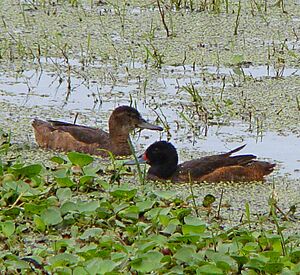Black-headed duck facts for kids
Quick facts for kids Black-headed duck |
|
|---|---|
 |
|
| Pair (male with black head) | |
| Conservation status | |
| Scientific classification | |
| Genus: |
Heteronetta
|
| Species: |
atricapilla
|
 |
|
| Range of black-headed duck | |
The black-headed duck (Heteronetta atricapilla) is a special type of duck found in South America. It lives in countries like Argentina, Bolivia, Brazil, Chile, Paraguay, and Uruguay. This duck is quite unique because of how it raises its young.
Contents
About the Black-headed Duck
The black-headed duck is the only species in its group, called Heteronetta. It's related to other ducks known as "stiff-tailed" ducks. However, it doesn't have the stiff tail or the big bill that its relatives do.
What Does It Look Like?
The black-headed duck is about 35 centimeters (14 inches) long. Males usually weigh around 510 grams (18 ounces). Females are a bit heavier, at about 565 grams (20 ounces).
This duck has a long body and wings that seem a bit short for its size. Its bill is black on top and orange underneath. During the breeding season, the top part of the bill gets a pinkish spot near its base.
- Males: Have a shiny black head and upper neck. Their chin is white. Their back feathers are dark brownish-black with small cinnamon or reddish-brown spots. When their wings are folded, you can see two white stripes. Their belly is whitish with brown spots, looking silvery.
- Females: Have a dark brown head and neck. Their throat is whitish. Otherwise, they look similar to the males.
- Young Ducks: Look like females but have more reddish-brown on their backs. Their bellies are more yellowish, and they have a pale stripe near their eyes.
Where Do Black-headed Ducks Live?
The black-headed duck lives in two main areas. One area is on the western side of central Chile. The other area stretches from southern Bolivia down through central Paraguay to central Argentina. It also goes east through southern Uruguay into the very south of Brazil.
These ducks mostly live in freshwater marshes. These are wet, grassy areas where a plant called Scirpus californicus grows a lot. When it's not breeding season, you might also find them in lakes, flooded ditches, or even flooded fields.
How Do Black-headed Ducks Behave?
Traveling Habits
The black-headed duck moves around a bit, so it's called partially migratory. It stays in most parts of its home range all year. However, in most of Paraguay and its small area in Bolivia, you'll only find it when it's not breeding season.
What Do They Eat?
Black-headed ducks find their food by diving underwater. We don't know a lot about their diet. But it seems they mostly eat seeds from the Scirpus californicus plant. They also eat a few snails.
How Do They Have Babies?
The black-headed duck is very special among ducks. It's an obligate brood parasite. This means the female duck does not build her own nest! Instead, she lays her eggs in the nests of other birds.
Some birds that host black-headed duck eggs include the rosy-billed pochard and two types of coots (the red-fronted coot and the red-gartered coot). People have reported at least 18 other bird species as hosts. These include other ducks, coots, gulls, and even some birds of prey!
Unlike some cuckoos, black-headed duck chicks or adult ducks do not harm the host's eggs or kill their chicks. The baby black-headed ducklings are born ready to go. After about 25 days of incubation, they are completely independent just a few hours after hatching. They leave the nest very quickly!
What Sounds Do They Make?
Black-headed ducks are usually quiet. Males make a low "quah quah" sound when they are trying to attract a mate. They also make a "two note grunt followed by a whistle: – gr-rump-freet." Females make "clucking notes."
Is the Black-headed Duck Safe?
The IUCN (International Union for Conservation of Nature) has listed the black-headed duck as being of Least Concern. This means they are not currently in danger of disappearing. They live across a large area. Even though we don't know exactly how many there are, their population seems to be stable. There are no immediate threats to them right now. However, changes to their wetland homes could affect them.


